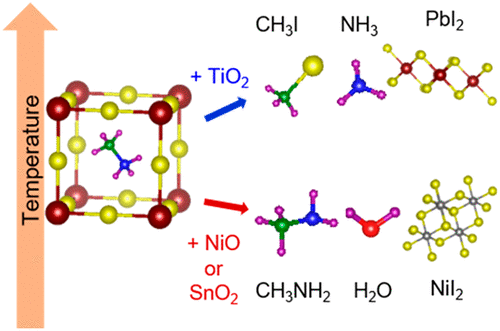当前位置:
X-MOL 学术
›
ACS Energy Lett.
›
论文详情
Our official English website, www.x-mol.net, welcomes your
feedback! (Note: you will need to create a separate account there.)
Altered Stability and Degradation Pathway of CH3NH3PbI3 in Contact with Metal Oxide
ACS Energy Letters ( IF 19.3 ) Pub Date : 2020-03-12 , DOI: 10.1021/acsenergylett.0c00041 Sampreetha Thampy 1 , Boya Zhang 1 , Ki-Ha Hong 2 , Kyeongjae Cho 1 , Julia W. P. Hsu 1
ACS Energy Letters ( IF 19.3 ) Pub Date : 2020-03-12 , DOI: 10.1021/acsenergylett.0c00041 Sampreetha Thampy 1 , Boya Zhang 1 , Ki-Ha Hong 2 , Kyeongjae Cho 1 , Julia W. P. Hsu 1
Affiliation

|
Degradation in CH3NH3PbI3 (MAPbI3), when in contact with commonly used metal oxide transport layer materials in optoelectronic devices, is examined experimentally and theoretically. On the basis of the decomposition temperature, the interfacial stability decreases in the following order: MAPbI3 + TiO2 ∼ MAPbI3 alone > MAPbI3 + SnO2 > MAPbI3 + NiO, consistent with thermodynamic data. When MAPbI3 contacts NiO or SnO2, experimental results unequivocally show interfacial decomposition occurs at a lower temperature than bulk decomposition and produces different degradation products. Density functional theory calculations reveal an altered reaction pathway on oxide surfaces and elucidate the difference between NiO and TiO2. These findings pinpoint the importance of understanding the interaction between halide perovskite and other materials used in a device to achieve intrinsically stable devices.
中文翻译:

CH 3 NH 3 PbI 3与金属氧化物接触的稳定性和降解途径的改变
降解在CH 3 NH 3碘化铅3(MAPbI 3在与常用的金属氧化物传输层的材料中的光电子器件接触时,被实验和理论研究)。在分解温度的基础上,所述界面稳定以下列顺序降低:MAPbI 3 +的TiO 2〜MAPbI 3单独> MAPbI 3 +的SnO 2 > MAPbI 3 +的NiO,热力学数据一致。当MAPbI 3接触NiO或SnO 2时实验结果明确表明,界面分解发生在比本体分解更低的温度下,并产生不同的降解产物。密度泛函理论计算揭示了氧化物表面上反应路径的改变,并阐明了NiO和TiO 2之间的差异。这些发现明确了理解钙钛矿卤化物与器件中使用的其他材料之间的相互作用以实现固有稳定器件的重要性。
更新日期:2020-04-23
中文翻译:

CH 3 NH 3 PbI 3与金属氧化物接触的稳定性和降解途径的改变
降解在CH 3 NH 3碘化铅3(MAPbI 3在与常用的金属氧化物传输层的材料中的光电子器件接触时,被实验和理论研究)。在分解温度的基础上,所述界面稳定以下列顺序降低:MAPbI 3 +的TiO 2〜MAPbI 3单独> MAPbI 3 +的SnO 2 > MAPbI 3 +的NiO,热力学数据一致。当MAPbI 3接触NiO或SnO 2时实验结果明确表明,界面分解发生在比本体分解更低的温度下,并产生不同的降解产物。密度泛函理论计算揭示了氧化物表面上反应路径的改变,并阐明了NiO和TiO 2之间的差异。这些发现明确了理解钙钛矿卤化物与器件中使用的其他材料之间的相互作用以实现固有稳定器件的重要性。











































 京公网安备 11010802027423号
京公网安备 11010802027423号